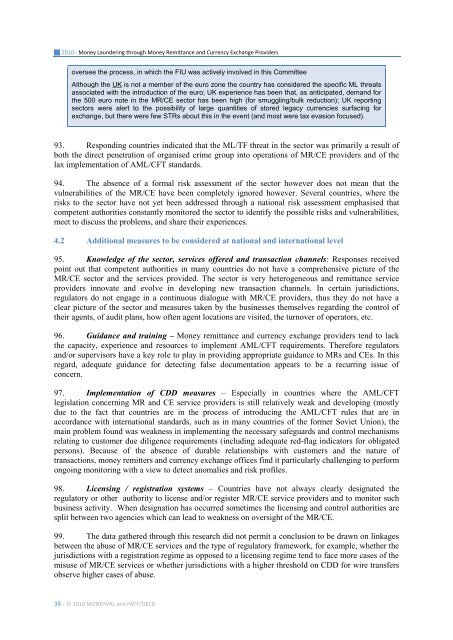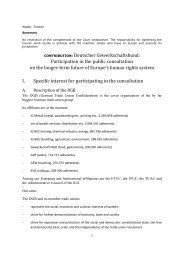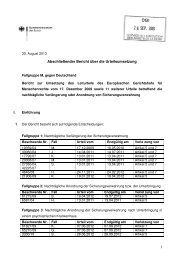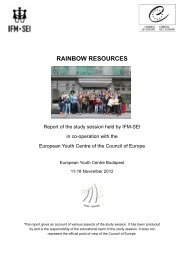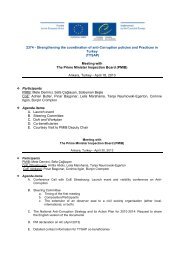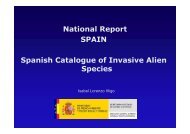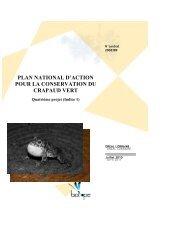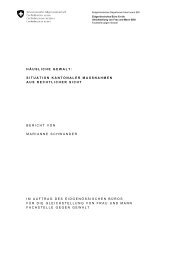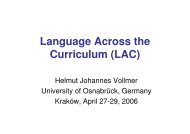Money laundering through money remittance ... - Council of Europe
Money laundering through money remittance ... - Council of Europe
Money laundering through money remittance ... - Council of Europe
You also want an ePaper? Increase the reach of your titles
YUMPU automatically turns print PDFs into web optimized ePapers that Google loves.
2010 - <strong>Money</strong> Laundering <strong>through</strong> <strong>Money</strong> Remittance and Currency Exchange Providers<br />
oversee the process, in which the FIU was actively involved in this Committee<br />
Although the UK is not a member <strong>of</strong> the euro zone the country has considered the specific ML threats<br />
associated with the introduction <strong>of</strong> the euro; UK experience has been that, as anticipated, demand for<br />
the 500 euro note in the MR/CE sector has been high (for smuggling/bulk reduction); UK reporting<br />
sectors were alert to the possibility <strong>of</strong> large quantities <strong>of</strong> stored legacy currencies surfacing for<br />
exchange, but there were few STRs about this in the event (and most were tax evasion focused).<br />
93. Responding countries indicated that the ML/TF threat in the sector was primarily a result <strong>of</strong><br />
both the direct penetration <strong>of</strong> organised crime group into operations <strong>of</strong> MR/CE providers and <strong>of</strong> the<br />
lax implementation <strong>of</strong> AML/CFT standards.<br />
94. The absence <strong>of</strong> a formal risk assessment <strong>of</strong> the sector however does not mean that the<br />
vulnerabilities <strong>of</strong> the MR/CE have been completely ignored however. Several countries, where the<br />
risks to the sector have not yet been addressed <strong>through</strong> a national risk assessment emphasised that<br />
competent authorities constantly monitored the sector to identify the possible risks and vulnerabilities,<br />
meet to discuss the problems, and share their experiences.<br />
4.2 Additional measures to be considered at national and international level<br />
95. Knowledge <strong>of</strong> the sector, services <strong>of</strong>fered and transaction channels: Responses received<br />
point out that competent authorities in many countries do not have a comprehensive picture <strong>of</strong> the<br />
MR/CE sector and the services provided. The sector is very heterogeneous and <strong>remittance</strong> service<br />
providers innovate and evolve in developing new transaction channels. In certain jurisdictions,<br />
regulators do not engage in a continuous dialogue with MR/CE providers, thus they do not have a<br />
clear picture <strong>of</strong> the sector and measures taken by the businesses themselves regarding the control <strong>of</strong><br />
their agents, <strong>of</strong> audit plans, how <strong>of</strong>ten agent locations are visited, the turnover <strong>of</strong> operators, etc.<br />
96. Guidance and training – <strong>Money</strong> <strong>remittance</strong> and currency exchange providers tend to lack<br />
the capacity, experience and resources to implement AML/CFT requirements. Therefore regulators<br />
and/or supervisors have a key role to play in providing appropriate guidance to MRs and CEs. In this<br />
regard, adequate guidance for detecting false documentation appears to be a recurring issue <strong>of</strong><br />
concern.<br />
97. Implementation <strong>of</strong> CDD measures – Especially in countries where the AML/CFT<br />
legislation concerning MR and CE service providers is still relatively weak and developing (mostly<br />
due to the fact that countries are in the process <strong>of</strong> introducing the AML/CFT rules that are in<br />
accordance with international standards, such as in many countries <strong>of</strong> the former Soviet Union), the<br />
main problem found was weakness in implementing the necessary safeguards and control mechanisms<br />
relating to customer due diligence requirements (including adequate red-flag indicators for obligated<br />
persons). Because <strong>of</strong> the absence <strong>of</strong> durable relationships with customers and the nature <strong>of</strong><br />
transactions, <strong>money</strong> remitters and currency exchange <strong>of</strong>fices find it particularly challenging to perform<br />
ongoing monitoring with a view to detect anomalies and risk pr<strong>of</strong>iles.<br />
98. Licensing / registration systems – Countries have not always clearly designated the<br />
regulatory or other authority to license and/or register MR/CE service providers and to monitor such<br />
business activity. When designation has occurred sometimes the licensing and control authorities are<br />
split between two agencies which can lead to weakness on oversight <strong>of</strong> the MR/CE.<br />
99. The data gathered <strong>through</strong> this research did not permit a conclusion to be drawn on linkages<br />
between the abuse <strong>of</strong> MR/CE services and the type <strong>of</strong> regulatory framework, for example, whether the<br />
jurisdictions with a registration regime as opposed to a licensing regime tend to face more cases <strong>of</strong> the<br />
misuse <strong>of</strong> MR/CE services or whether jurisdictions with a higher threshold on CDD for wire transfers<br />
observe higher cases <strong>of</strong> abuse.<br />
38 - © 2010 MONEYVAL and FATF/OECD


